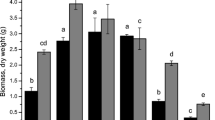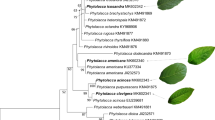Abstract
Few studies have been carried out on the effects of ligands on rare earth element (REE) bioaccumulation processes. In this study, the effects of phosphate (Pi, an inorganic ligand) and citrate (an organic ligand) on accumulation and fractionation of REEs in wheat were investigated using aqueous culture with extranous mixed REEs (MRE). The results show that initial Pi solution culture at various levels followed by exposure to a fixed-MRE solution did not significantly change the total concentrations of REEs (ΣREE) in roots, whereas the ΣREE in leaves dramatically decreased with increasing levels of Pi applied. Simultaneous culture of wheat with mixture of MRE and citrate solutions caused obvious decreases of the ΣREE in both roots and leaves. Compared with MRE, significant fractionations of REEs were found in wheat organs when no ligand was applied. Notable middle REE (MREE) enrichment and M-type tetrad effect were observed in the roots, and heavy REE (HREE) enrichment and W-type tetrad effect existed in the leaves. Pi treatments did not significantly affect the fractionations of REEs in the roots, but enrichment of HREEs in the leaves slightly increased at the highest level of Pi applied. Fractionations of REEs in both roots and leaves decreased with increasing levels of citrate applied; at higher levels of citrate (≥150 μM), no above fractionation features were observed in wheat, but light REE (LREE) enrichment existed in the roots and leaves. The results indicate that ligands might play important roles in accumulation and fractionation of REEs during bioaccumulation processes.
Similar content being viewed by others
References
A. Montaser, Inductively Coupled Plasma Mass Spectrometry, Wiley-VCH, New York (1998).
S. A. Wood, The aqueous geochemistry of the rare-earth elements and yttrium, I. Review of available low-temperature data for inorganic complexes and the inorganic REE speciation of natural waters, Chem. Geol. 82, 159–186 (1990).
S. A. Wood, The aqueous geochemistry of the rare-earth elements and yttrium: critical stability constants for complexes with simple carboxylic acids at 25°C and 1 bar and their application to nuclear waste management, Eng. Geol. 34, 229–259 (1990).
F. J. Millero, Stability constants for the formation of rare earth inorganic complexes as a function of ionic strength, Geochim. Cosmochim. Acta 56, 3123–3132 (1998).
J. H. Lee and R. H. Byrne, Examination of comparative rare earth element complexation behavior using linear free-energy relationships, Geochim. Cosmochim. Acta 56, 1127–1137 (1992).
R. H. Byrne and B. Q. Li, Comparative complexation behaviour of the rare earth, Geochim. Cosmochim. Acta 59(22), 4575–4589 (1995).
F. F. Fu, T. Akage, and K. Shinotsuka. Distribution patterns of rare earth elements in fern: implication for intake of fresh silicate particles by plants, Biol. Trace Element Res. 64, 13–26 (1998).
A. Wyttenbach, P. Schleppi, J. Bucher, V. Furrer, and L. Tobler, The accumulation of the rare earth elements and of scandium in successive needle age classes of Norway spruce, Biol. Trace Element Res. 41, 13–29 (1994).
M. Bernd and D. L. Zhang, Natural background concentrations of rare-earth elements in a forest ecosystem, Sci. Total Environ. 103(1), 27–35 (1991).
N. Miekeley, E. A. Casartelli, and R. M. Dotto, Concentration levels of rare-earth elements and thorium in plants from the Morro Do Ferro environment as an indicator for the biological availability of transuranium elements. J. Radioanal. Nucl. Chem. 182, 75–89 (1994).
A. Wyttenbach, V. Furrer, P. Schleppi, and L. Tobler, Rare earth elements in soil and in soil-grown plants, Plant Soil 199, 267–273 (1998).
F. F. Fu, A. Tasuku, Y. Sadayo, and I. Masaya, The variation of REE (rare earth elements) patterns in soil-grown plants: a new proxy for the source of rare earth elements and silicon plants, Plant Soil 235, 53–64 (2001).
P. Henderson, About rare earth elements, in Rare Earth Element Geochemistry, P. Henderson, ed., Elsevier, New York, pp. 1–50 (1984).
S. R. Tarlor and S. M. McLennan, The significance of the rare earths in geochemistry and cosmochemistry, in Handbook on the Physics and Chemistry of Rare Earths, K. A. Gschneider and L. Eyring, eds., Elsevier, New York, pp. 435–479 (1988).
D. G. Brookins, Aqueous geochemistry of rare earth elements, in Geochemistry and Mineralogy of Rare Earth Elements, Reviews in Mineralogy, Vol. 21, B. R. Lipin and G. A. Mckay, ed., Mineralogical Society of America, Washington, DC, pp. 201–225 (1989).
Z. G. Wei, M. Yin, and X. Zhang, Rare earth elements in naturally grown fern Dicranopteris linearis in relation to their variation in South-Jiangxi region, Environ. Pollut. 114, 345–355 (2001).
S. M. Ding, T. Liang, L. J. Wang, and Q. Sun, Characteristics of translocation and fractionation of rare earth elements in soil-wheat system, J. Agro-environ. Sci. 22(5), 519–523 (2003).
X. K. Xu, W. Z. Zhu, and Z. J. Wang, Distributions of rare earths and heavy metals in field-grown maize after application of rare earth-containing microfertilizer, Sci. Total Environ. 293, 97–105 (2002).
F. F. Fu and A. Tasuku, Distribution of rare earth elements in seaweed: implication of two different soruces of rare earth elements and silicon in seaweed. J. Phycol. 36, 62–70 (2000).
A. Masuda, Q. Kawakami, Y. Dohmoto, and T. Takenaka, Lanthanide tetrad effects in nature: two mutually opposite types W and M, Geochem. J. 21, 119–124 (1987).
S. M. Mclennan, Rare earth element geochemistry and the “tetrad” effect, Geochim. Cosmochim. Acta 58(9), 2025–2033 (1994).
W. Irber, The lanthanide tetrad effect and its correlation with K/Rb Eu/Eu*, Y/Ho and Zr/Hf of evolving peraluminous granite suites, Geochim. Cosmochim. Acta 63, 489–508 (1999).
T. Monecke, U. Kempe, J. Monecke, M. Sala, and D. Wolf, Tetrad effect in rare earth element distribution patterns: a method of quantification with application to rock and mineral samples from granite-related metal deposits, Geochim. Cosmochim. Acta 66(70), 1185–1196 (2002).
R. H. Byrne, X. Liu, and J. Schijf, The influence of phosphate coprecipitation of rare earth distributions in natural waters, Geochim. Cosmochim. Acta 60(17), 3341–3346 (1996).
R. M. Welch and W. A. Norvell, Mechanisms of cadmium uptake, translocation and deposition in plants, in Cadmium in Soils and Plants, Volume 85, M. J. McLaughlin and B. R. Singh, eds., Kluwer Academic, Dordrecht, The Netherlands, pp. 125–150 (1999).
Y. X. Chen, Q. Lin, Y. M. Luo, et al. The role of citric acid on the phytoremediation of heavy metal contaminated soil, Chemosphere 50, 807–811 (2003).
Q. Lin, Chemical behavior of Cd and Pb in rhizosphere and its uptake by plants. PhD thesis, Institute of Soil Science, Chinese Academy of Science (1996).
A. E. Mailer, D. Rosalyn, R. D. Matthews, J. A. McDowell, R. R. Walden, and B. A. Ahner, Environmental cadmium levels increase phytochelation and glutathione in letture grown in a chelator-buffered nutrient solution, J. Environ. Qual. 32, 1356–1364 (2003).
A. L. Epstein, C. D. Gussman, M. J. Blaylock, et al. EDTA and Pb-EDTA accumulation in Brassica juncea grown in Pb-amended soil, Plant Soil 208, 87–94 (1999).
A. D. Vassil, Y. Kapulnik, I. Raskin, and D. E. Salt, The role of EDTA in lead transport and accumulation by Indian mustard, Plant Physiol. 117, 447–453 (1998)
S. A. Barber, Soil Nutrient Bioavailability: A Mechanistic Approach, Wiley, New York (1984).
G. X. Xing and J. G. Zhu, Chemistry of Trace Elements and Rare Earth Elements in Soil, Science Press, Beijing, (2003).
P. J. Hocking, The composition of phloem exudate and xylem sap from tree tobacco (Nicotiana glauca Groh), Ann. Bot. 45, 633–643 (1980).
H. Marschner, Mineral Nutrition of Higher Plants, Academic, Cambridge (1995).
D. L. Jones, Organic acids in the rhizosphere—a critical review, Plant Soil 205, 25–44 (1998).
D. L. Jones, P. G. Dennis, and A. G. Owen, Organic acid behavior in soils—misconceptions and knowledge gaps, Plant Soil 248, 31–41 (2003)
R. Baziramakenga, R. R. Simard, and G. D. Leroux, Determination of organic acids in soil extracts by ion chromatography, Soil Biol. Biochem. 27, 349–356 (1995).
A. J. Krzyszowska, M. J. Blaylock, G. F. Vance, and M. B. David, Ion-chromatographic analysis of low molecular weight organic acids in spodoso forest floor solutions, Soil Sci. Soc. Am. J. 60, 1565–1571 (1996).
B. W. Strobel, Influence of vegetation on low-molecular-weight carboxylic acids in soil solution—a review, Geoderma 99, 169–198 (2001).
D. L. Jones and P. R. Darrah, Role of root derived organic acids in the mobilization of nutrients from the rhizosphere, Plant Soil 166, 247–257 (1994).
X. Q. Shan, L. Jun, and W. Bei, Effect of organic acids on adsorption and desorption of rare earth elements, Chemosphere 47, 701–710 (2002).
Author information
Authors and Affiliations
Rights and permissions
About this article
Cite this article
Ding, S., Liang, T., Zhang, C. et al. Role of ligands in accumulation and fractionation of rare earth elements in plants. Biol Trace Elem Res 107, 73–86 (2005). https://doi.org/10.1385/BTER:107:1:073
Received:
Revised:
Accepted:
Issue Date:
DOI: https://doi.org/10.1385/BTER:107:1:073




